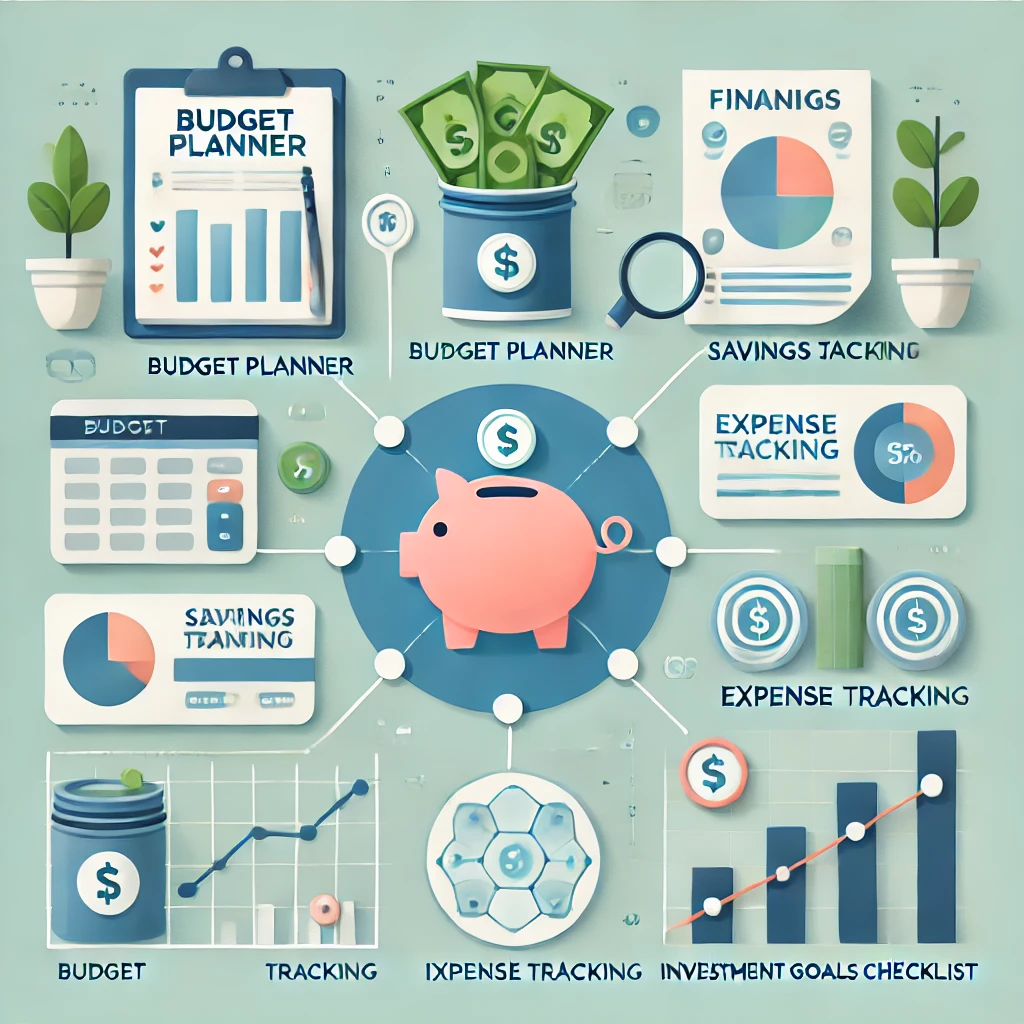How to Organize Your Personal Finances in 5 Steps: A Guide for a Brighter Financial Future Personal Finances 2025
Taking control of your personal finances is one of the key foundations for achieving stability, How to Organize Your Personal Finances in 5 Steps: A Guide for a Brighter Financial Future Personal Finances reducing stress, and turning your dreams into reality. Many people struggle to balance their income and expenses, often falling into debt or simply not knowing where to start. This guide will walk you through five practical and transformative steps to help you get a clear picture of your financial situation and create a sustainable plan for the future. Personal Finances
1. Assess Your Financial Situation Personal Finances
The very first step to organizing your finances is understanding exactly where you stand. Without an accurate assessment, it’s hard to know what changes to make or which habits to adjust.
List Your Income and Expenses
- Identify All Income Sources: Include your regular paycheck, freelance or side hustle earnings, investment returns, and any other sources of income. This gives you a full picture of the funds you have available each month.
- Record Every Expense: Divide your expenses into fixed and variable categories. Fixed expenses might include rent or mortgage, utilities (electricity, water, internet), transportation, and groceries. Variable expenses can be entertainment, dining out, clothing, and miscellaneous daily costs.
Use Financial Tools
Take advantage of budgeting apps, spreadsheets, or even a simple notebook to track every transaction—even the small change. The goal is to know exactly where your money is going.
Evaluate Your Debt
If you have debts—whether credit card balances, loans, or other forms—list them out along with their interest rates and payment deadlines. This will help you prioritize paying off high-interest debts and consider renegotiating terms if needed.
By the end of this assessment, you should have a clear understanding of your cash flow: what comes in, what goes out, and what’s left over. This clarity is essential for building a solid financial plan.
2. Set Goals and Create a Budget Personal Finances
Once you’ve evaluated your current situation, the next step is to define where you want to go and how to use your money to get there. Clear goals and a realistic budget empower you to make informed decisions and stick to your plan. Personal Finances
Define Your Financial Goals
Ask yourself: What do I want to achieve? Some common goals include:
- Paying off existing debt
- Building an emergency fund
- Saving for a vacation or a down payment on a house
- Investing for retirement or future education
Make sure your goals are specific, measurable, achievable, relevant, and time-bound (SMART). Having well-defined objectives keeps you motivated and allows you to adjust your steps as needed.
Create a Monthly Budget
Based on your financial assessment, design a budget that details all your income and expenses. A popular method is the 50-30-20 rule:
- 50% for Needs: Essential expenses such as housing, food, utilities, and transportation.
- 30% for Wants: Non-essential spending like dining out, entertainment, and hobbies.
- 20% for Savings and Debt Repayment: Allocate this portion toward building an emergency fund, investing, or paying off debts.
If this division doesn’t exactly fit your situation, modify it so your budget realistically reflects your lifestyle. The key is to have a plan that guides you on how much you can spend without compromising your financial goals.
Track Your Budget
Having a budget is great, but the real value comes from regularly monitoring it. Record your expenditures, compare them to your planned budget, and adjust the figures as needed. This ongoing review helps you pinpoint any overspending and reallocate funds to the areas that matter most.
3. Control Your Spending and Eliminate Unnecessary Expenses Personal Finances
With a clear picture of your finances and a solid budget in place, it’s time to take action by trimming expenses that do not contribute to your overall financial well-being.
Analyze Your Spending Habits
Go through your expense list and ask yourself: Is this purchase really necessary? Small, daily expenses—like a coffee on the go, frequent dining out, or unused subscriptions—can add up over time and derail your budget. Identify which costs can be reduced or eliminated altogether.
Set Spending Limits and Avoid Impulse Buying
- Plan Your Purchases: Before heading out to shop or placing an order online, make a list of what you truly need. This helps you resist impulsive buys.
- Limit Discretionary Spending: While you shouldn’t cut out fun entirely, setting a cap on entertainment or dining out can make a big difference.
- Adopt a Cash-Only Approach: Consider using the envelope method, where you allocate a specific amount of cash for different spending categories. This physical limit can be a powerful deterrent against overspending.
Manage Your Debt Wisely
If you have high-interest debts—especially on credit cards—make these your top priority. Look into consolidating your debts or negotiating lower interest rates to make repayments more manageable. Avoid taking on new debt unless absolutely necessary, as it can quickly snowball and strain your budget further.
4. Build an Emergency Fund and Invest in Your Future Personal Finances
Once you’ve streamlined your expenses, it’s essential to plan for the unexpected and invest in your long-term financial health. Personal Finances
Establish an Emergency Fund
An emergency fund is a safety net designed to cover unforeseen expenses such as medical emergencies, car repairs, or temporary income loss. Financial experts recommend setting aside at least three to six months’ worth of living expenses in a high-liquidity, low-risk account like a savings account or money market fund.
- Start Small and Be Consistent: If saving several months’ expenses feels overwhelming, begin by setting aside a portion of your paycheck each month. Over time, your emergency fund will grow and provide the security you need.
Invest in Your Future
In addition to an emergency fund, it’s crucial to put money to work by investing. Your investment options can vary based on your risk tolerance and financial goals:
- Fixed Income: Consider bonds, certificates of deposit (CDs), or high-yield savings accounts for stable returns.
- Stocks and Mutual Funds: If you’re comfortable with more risk, investing in equities or mutual funds can potentially offer higher returns.
- Retirement Accounts: Setting up or contributing more to an IRA or 401(k) plan is a smart way to secure your future.
Investing isn’t just about earning more—it’s about making your money grow so that you can eventually achieve your dreams, whether that’s buying a home, traveling the world, or retiring comfortably.
5. Monitor, Review, and Adjust Your Plan Personal Finances
The financial landscape and your personal circumstances are always evolving. For your financial plan to remain effective, it must be continuously monitored and adjusted. Personal Finances
Regularly Review Your Finances
- Monthly Budget Check: Compare your planned budget against your actual spending. Identify any discrepancies and adjust your categories if needed.
- Update Your Income and Expense Records: Whenever there is a significant change—like a salary increase, new expense, or debt payoff—update your financial records.
- Use Reports and Graphs: Many digital tools offer reports that visualize your spending and saving trends. These insights can be very motivating and help you stay on track.
Adjust Your Goals as Needed
Your priorities may shift over time. Perhaps you’ve reached one goal and need to set a new target, or maybe your financial situation has changed. Regularly re-evaluate your objectives to ensure they continue to align with your needs and aspirations.
Celebrate Your Achievements
Organizing your finances is a continuous journey. Whether you’ve successfully paid off a debt, managed to stick to your budget for a month, or increased your savings rate, celebrating these milestones reinforces positive habits and keeps you motivated.
Conclusion Personal Finances
Organizing your personal finances in five clear steps requires self-awareness, discipline, and commitment. By assessing your financial situation, setting clear goals and creating a realistic budget, controlling spending, building an emergency fund, and investing in your future, you create a strong foundation for financial stability. Regularly monitoring and adjusting your plan ensures that you remain adaptable to life’s changes while steadily moving toward your goals.
Remember, every small step counts. Even if the transformation doesn’t happen overnight, persistence and discipline will pay off in the long run. Take control of your finances today—start by gathering your receipts, opening your budgeting app or spreadsheet, and taking that crucial first step toward a healthier, more secure financial future. Your future self will thank you. Personal Finances
We hope this guide helps you transform your relationship with money. Organizing your finances isn’t just about cutting costs; it’s about creating a secure pathway to achieve your dreams and face life’s challenges with confidence. Start now and experience the difference that a well-thought-out financial plan can make!Personal Finances
Discover how to transform your relationship with money and finally achieve that long-awaited financial freedom. If you’ve ever felt overwhelmed by debt, disorganized budgets, and the sense that your money is simply vanishing, it’s time to take control.
In the e-book Master of Finances: How to Control Your Money and Achieve Financial Freedom, Ler mais renowned economist Tayrine Campos reveals practical, innovative strategies to help you:
- Analyze and effectively reorganize your financial situation;
- Create and maintain a realistic budget that truly works;
- Eliminate debt and invest with confidence;
- And most importantly, turn financial challenges into opportunities for a secure future.
This guide is perfect for anyone who wants to seize control of their finances, break free from the cycle of debt, and begin paving the way toward financial independence. If you’re ready to take the first step toward a worry-free financial life, check out this comprehensive and transformative guide:
Check out the Master of Finances e-book
Seize this opportunity and start writing a new chapter in your financial story!

Share this content:




Post Comment